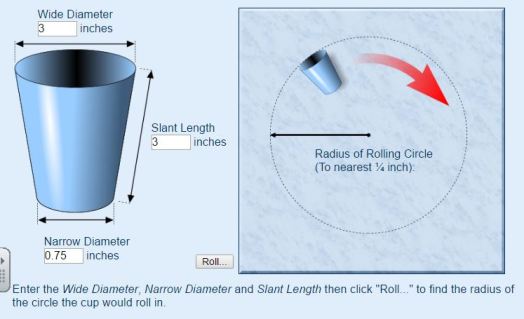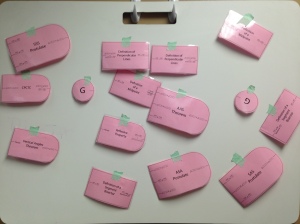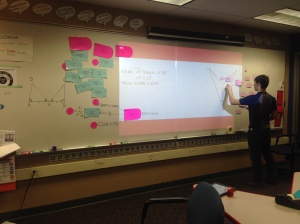I usually use the last six week of the school year in geometry to teach circles: Arc lengths, chords, secants, tangents, etc. Which I have outlined in the Geometry Planning Guide
The following school year students begin Algebra 2 and promptly forget these properties of circles. They also start the new school year frustrated and overwhelmed because they forgot all about the quadratics they learned in Algebra 1 during their year in geometry.
This school year I decided to make some changes to the last unit in order to set students up to be more successful in the transition from Geometry to Algebra 2:
1) I began with a modified version of Fawn’s task: When I got them to beg
I distributed an index card to each student and gave them students 5 minutes to make a beautiful work of art on the card. When time was up, students turned in their art, I shuffled the cards and redistributed them to the class.
I cut orange paper to the same size as 3×5 inch index cards, and told the students it was “Real Gold” it was very expensive and we could not waste any of it (they referred to orange paper as “Gold” for the rest of the school year). They had to try to make a frame for the art and tape it down to the assignment sheet that I distributed to them with an explanation of their thinking and strategy.
It worked. They begged me to help them find a better way to complete this task.
2) Complete the Square with algebra tiles.
I used this activity from Salt Lake City Schools to guide student thinking. Students worked in small groups to create squares using algebra tiles and relating the squared and factored forms of perfect square quadratic equations. We referred back to this task often throughout the unit.
3) Solving equations by Completing the square notes and practice
I used Sarah Hagan’s foldable for completing the square. The following day I planned a basic practice sheet for students to just build fluency with solving equations by completing the square, but it was so nice out, we decided to do this on the sidewalk instead. (Note: Always keep sidewalk chalk in your classroom for beautiful day emergencies)
4) Applications of completing the square
I returned students framed art task from day 1 above, and they wrote and equation and found the appropriate frame size using completing the square, then measured their estimated solution and reflected on their work.
Next we completed the Shell center task: Cutting Corners
5) Connecting Quadratic equations to Parabolas
I printed and laminated sets of the domino cards from the Shell Center task: Representing Quadratic Functions Graphically and students completed the loop and filled in the blanks. They then were able to summarize the relationship between standard, vertex and factored form of a quadratic equation and understand what each of the forms of the equation illustrated about it’s graph.
The next day, students worked on the Desmos Activity: Match My Parabola. I was able to pause and pace this activity as needed and monitor students understanding in order to support students understanding of the various forms of a quadratic equation.
6) Converting a quadratic equation between vertex, standard and factored forms
Now that students understood the usefulness of the various forms of quadratic equations, they wanted to be able to convert a quadratic equation between the various forms:
6) Develop the equation of a circle
I started with this question:

There were a few students who shouted out “Pythagorean Theorem!” and students realized they could construct a right triangle and find the length of the hypotenuse/radius.
Next, I gave students individual whiteboards and asked them to draw a circle centered at (0,0) with a radius of 5. Then I asked them to name coordinates of points that they know for sure were on the circle and I would have them explain how they knew. Eventually we identified 12 points on the circle.
After this, I asked students what the relationship was between the x and y coordinates on the circle. Most groups were able to explain that they were all related by the Pythagorean theorem because x² + y² = 5².
At this point, I had students complete the first side of the “Going Round in Circles” sheet from this Shell Center lesson in order to see how well students understood the discussion and to see how they could apply their learning.
The next class period began by asking students to find the radius of a circle given the coordinates of the center and a point:
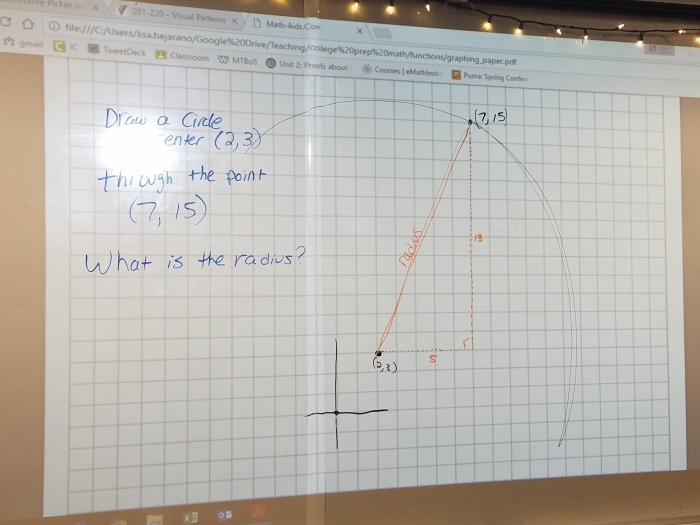
We used this to determine the radius of this circle as (7 – 2)² + (15 – 3)² = 13²
After further discussion, students were able to generalize the equation of a circle centered at (h, k) to be: (x – h)² + (y – k)² = r²
Then students worked in small groups on the vertical white boards to complete the task included in the Shell center lesson: Sorting Equations of Circles 1
I printed and laminated the cards to make them easier to use on vertical dry erase boards and for facilitate discussion.
Finally, students completed the “Going Round in Circles, Revisited” sheet included in the lesson linked above.
7) Find the center and radius of a circle by completing the square
I created a foldable for students to summarize the equation of a circle that included examples of using completing the square to put an equation of a circle into a standard form. We followed this with additional practice.
<foldable below should be printed on legal sized paper>
Every time we referred back to completing the square I made visual diagrams connecting it back to their initial development of their understanding of how to complete a square. I never stated any shortcut like, “just divide by 2 and square it.”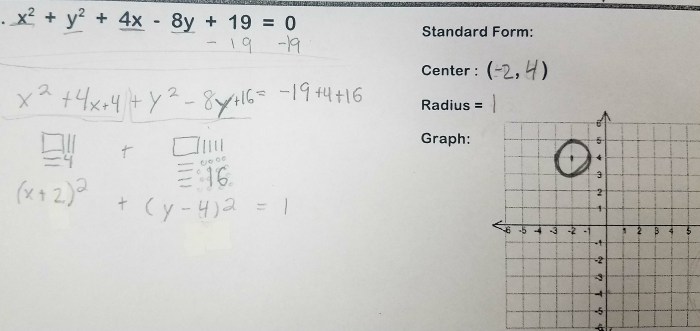 Students developed a genuine understanding of the process, which will hopefully lead them to increased success as they begin algebra 2 next school year.
Students developed a genuine understanding of the process, which will hopefully lead them to increased success as they begin algebra 2 next school year.



















